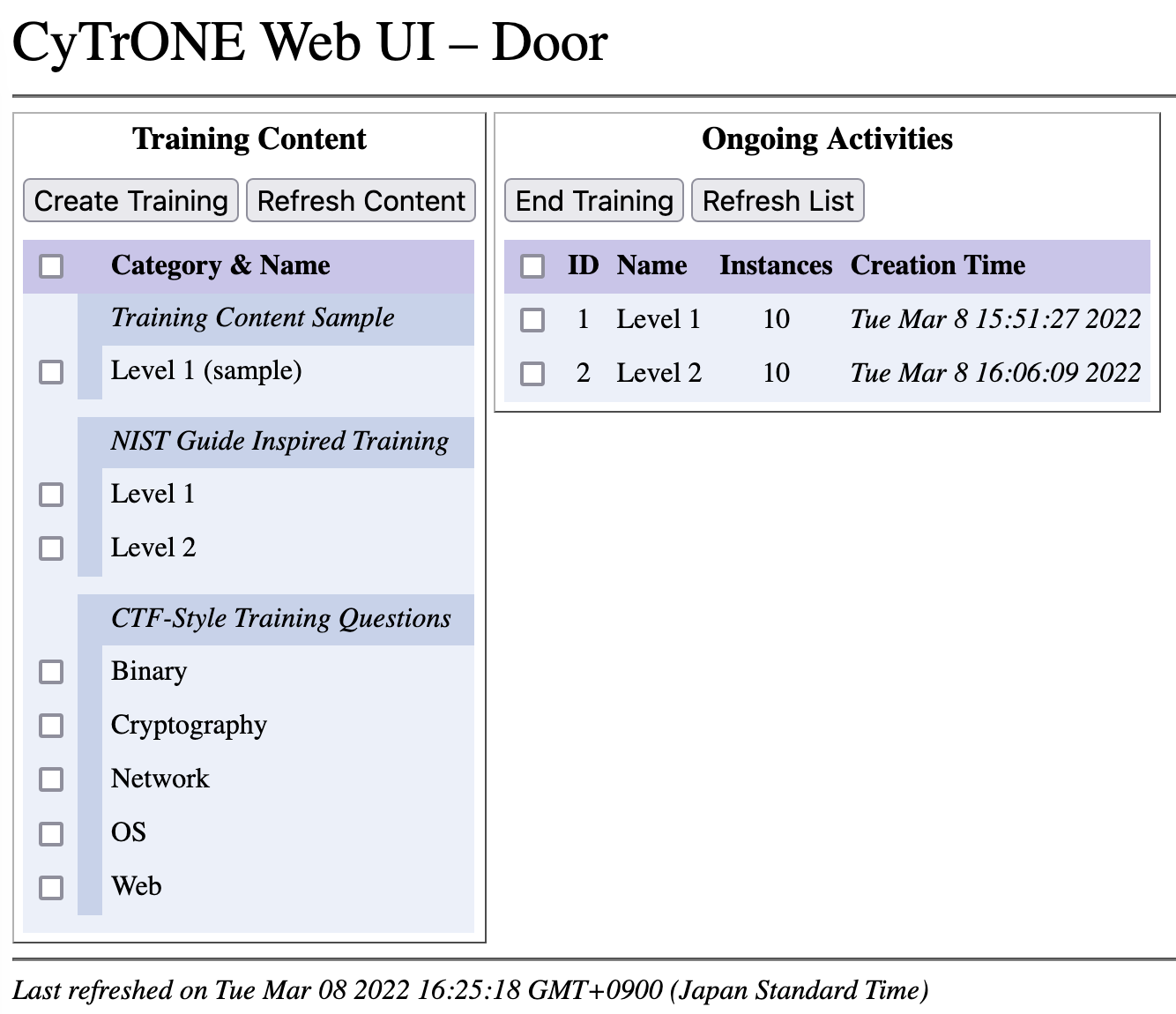CyTrONE Web UI is a web browser user interface for the integrated cybersecurity training framework CyTrONE. The interface is intended for training instructors, who can use it to create new training sessions and to terminate existing ones. CyTrONE Web UI is being developed by the Cyber Range Organization and Design (CROND) NEC-endowed chair at the Japan Advanced Institute of Science and Technology (JAIST).
A screenshot of the web interface is shown in the figure below. In the left-hand side panel existing training content is displayed, and the Create Session button can be used to create a new training session (the number of requested cyber range instances should be set via the dialog box shown subsequently). The right-hand side panel displays the active training sessions, and can be used to terminate them via the End Session button. Both the training content and active sessions panels can be refreshed by clicking the corresponding buttons in case the data was updated externally (e.g., new content was added to CyTrONE while the UI was running).
Next we provide brief information on how to setup and use CyTrONE Web UI. For more details, please refer to the User Guide made available in the v0.3 release.
CyTrONE Web UI has been developed using the Perl programming language on Ubuntu 18.04 LTS, so installing Perl is required if it is not installed already. To do that, run the following command:
$ sudo apt-get install perl
Then the necessary Perl modules need to be installed, for example by
using the cpan command. The list of required Perl modules is as
follows:
Net::WebSocket::ServerYAML::TinyURI::EscapeDigest::MD5Data::DumpLWP::Protocol::https
While there is no installation procedure for CyTrONE Web UI, changing
its settings according to your environment is necessary. This is
accomplished by creating a configuration file based on the sample
provided in door.conf.dist. The settings included in this sample are
explained below:
-
Configure the address and port on which the UI will listen for web browser connections; for example, to make possible connecting via
http://192.168.1.1:8080, you should specify the following settings:httpd_addr 192.168.1.1 httpd_port 8080 wsd_addr 192.168.1.1 -
Configure the user name and password for connecting to the web UI; for example, to make possible connecting via the user
cy_userand passwordcy_passwd, you should specify the following settings:httpd_userpasswd cy_user cy_passwdNote that the user name and password specified here are also used to authenticate with CyTrONE, so these values must match those set for the CyTrONE server.
-
Configure the settings used when the UI connects to the CyTrONE server; for example, to use the
httpsprotocol to connect locally (assuming the UI and CyTrONE are installed on the same host), and to retrieve English language content, use the following settings:trngsrv_proto https trngsrv_host 127.0.0.1 trngsrv_lang en
Depending on the configuration of the SSL server certificate for your CyTrONE server, such as in the case of using self-signed certificates, you may also need to disable the host name verification in the Perl SSL implementation via the following command:
$ export PERL_LWP_SSL_VERIFY_HOSTNAME=0
In order to start CyTrONE Web UI, run the command below (assuming that
the configuration file you created above is named door.conf):
$ perl door.pl -f door.conf
The UI program can be stopped simply by entering Ctrl-C in the
terminal where it was started.
All the available command-line options can be viewed using the
argument -h when running the program:
$ perl door.pl -h
door.pl - A UI server for CyTrONE by k-chinen, CROND, JAIST. 2017-2018.
usage: door.pl [-f <file>] [options]
option: ; default value
-h print this message ;
-v print version ;
-V print parameters ;
-f file read cofiguration file ;
-p port HTTP service port number ; 10080
-a addr HTTP service address ; 127.0.0.1
URL http://127.0.0.1:10080/
-c dirs HTTP document root directories ; htmldoc
-P port WS service port number ; 12345
-A addr WS service address ; 127.0.0.1
URL ws://127.0.0.1:12345/junk
-d debug mode ; 0
-D string debug-masking of module,protocol;
-q quiet mode ; 0
-m trace messages intro syslog ; 0
-z sleep until client access ;
example:
% door.pl -p 4989 -P 3213 -c docroot
% door.pl -f door.conf
For more details about CyTrONE Web UI, including internal architecture details, please refer to the User Guide made available in the v0.3 release.
For a list of contributors to this project, please check the file CONTRIBUTORS included with the source code.
